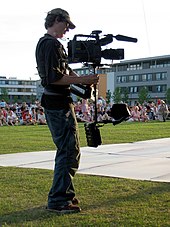Steadicam

A camera operator using the Steadicam in front of an audience.
|
|
| Product type | Camera stabilizer |
|---|---|
| Owner | Tiffen |
| Country | United States |
| Introduced | 1975 |
| Website | steadicam.com |
Steadicam is a brand of camera stabilizer mounts for motion picture cameras invented by Garrett Brown and introduced in 1975 by Tiffen. It mechanically isolates the operator's movement, allowing for a smooth shot, even when the camera moves over an irregular surface.
Before the camera stabilizing system, a director had two choices for moving (or "tracking") shots:
While these cinematic techniques are still common, the Steadicam has added another dimension to motion picture cinematography and videography.
A Steadicam essentially combines the stabilized steady footage of a conventional tripod mount with the fluid motion of a dolly shot and the flexibility of hand-held camera work. While smoothly following the operator's broad movements, the Steadicam's armature absorbs jerks, bumps, and shakes.
The Steadicam was introduced to the industry in 1975 by inventor and cameraman Garrett Brown, who originally named the invention the "Brown Stabilizer". After completing the first working prototype, Brown shot a ten-minute demo reel of the revolutionary moves this new device could produce. This reel was seen by numerous directors, including Stanley Kubrick and John G. Avildsen. The Steadicam was subsequently licensed to and manufactured by Cinema Products Corporation, which later diversified the brand into a consumer line for DV cameras.
The Steadicam was first used in the Best Picture–nominated Woody Guthrie biopic Bound for Glory (1976), debuting with a shot that compounded the Steadicam's innovation: cinematographer Haskell Wexler had Brown start the shot on a fully elevated platform crane which jibbed down, and when it reached the ground, Brown stepped off and walked the camera through the set. This technically audacious and previously impossible shot created considerable interest in how it had been accomplished, and impressed the Academy enough for Wexler to win the Oscar for Best Cinematography that year.
...
Wikipedia
